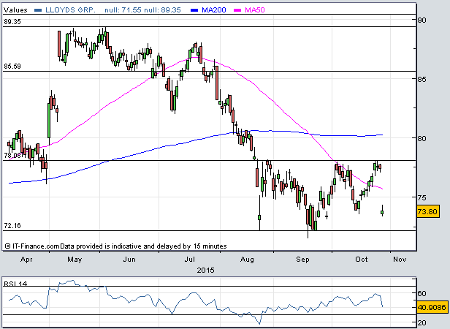Lloyds' profits miss could be buying opportunity ahead of IPO
28th October 2015 12:37
by Harriet Mann from interactive investor
Share on
As the government gears up to sell its final stake in next spring, tougher commercial banking conditions helped drag profits below expectations in the third quarter. However, management believes performance will recover in the final three months of the year and one analyst reckons the market's reaction could present an attractive investment opportunity ahead of the share offer.
Driven by a poor performance in other income, group underlying profit fell from £2.2 billion to £1.97 billion in the third quarter, giving earnings per share of 0.8p - a big miss against Investec's forecast of 1.6p. Down 13% on the year at £1.4 billion, other income struggled due to weaker insurance performance, tougher conditions in commercial banking and lower income from run-off assets in the third quarter. Although this should recover in the fourth quarter, it will still underperform last year.
Thanks to improved impairment charges across the first three quarters of the year, underlying profit rose 6% to £6.4 billion, despite the sale of TSB to Spain's Banco Sabadell in the first quarter and the resumption of dividends. At £336 million, the impairment charge is two thirds lower than last year after a reduction in run-off businesses and improvements in all divisions. Lloyds' asset quality ratio has improved by 15 basis points to 0.11%.
Another PPI provision
Taking the total provision to £1.9 billion so far this year, Lloyds has set aside another £500 million provision for mis-sold payment protection insurance (PPI). The bank side-lined a massive £1.4 billion PPI top-up in its second quarter, as it took advantage of the final opportunity to apportion cash for future payments on a tax deductible basis.
Data from the Financial Conduct Authority shows that total redress PPI payments fell 8% on the previous month to £300.5 million in August, the lowest monthly total since September 2011. The financial regulator is considering a 2018 deadline for people to claim against any miss-sold PPI insurance.
Lloyds' cost/income ratio improved to 48% in the nine months, despite additional investment and simplification costs. A jump in net interest income driven by margin improvements was offset by falling income elsewhere in the business, which kept total income flat at £13.2 billion in the first nine months of the year. Net interest margin, a key profit measurement, rose from 2.47% to 2.64%.
"Lloyds has historically been a core holding for UK income investors and the resumption of dividends had been a key component of investor interest," explains Interactive Investor's head of investment Rebecca O'Keeffe.
"However, the miss on underlying profits has dampened expectations of a steady increase in future dividends and this has seen the share price fall."
Steps to strengthen Lloyds' balance sheet are making progress: the group's common equity tier 1 (CET1) ratio has risen to 13.7%, from 13.3% in June and 12.8% in December 2014. Tangible net assets are now worth 55p per share, up from 54.9p in December.
"The robust UK economy and our differentiated business model underpin our continued confidence in generating strong and sustainable returns," said the group.
Lloyds' share price fell 4.5% at the open to just under 74p, tracking away from its 78p technical resistance (see chart). Accendo Markets research analyst Augustin Eden wonders whether investors should take advantage.
"At 74p LLOY surely remains the pick of the UK retail banks in terms of recovery potential, dividend yield and the general fuss being made about the Government offloading the British taxpayer's remaining stake (to the British taxpayer), while today's 4% discount makes the stock potentially even more attractive to pick up right now, ahead of next March's much-talked about share offer."

(click to enlarge)
This article is for information and discussion purposes only and does not form a recommendation to invest or otherwise. The value of an investment may fall. The investments referred to in this article may not be suitable for all investors, and if in doubt, an investor should seek advice from a qualified investment adviser.